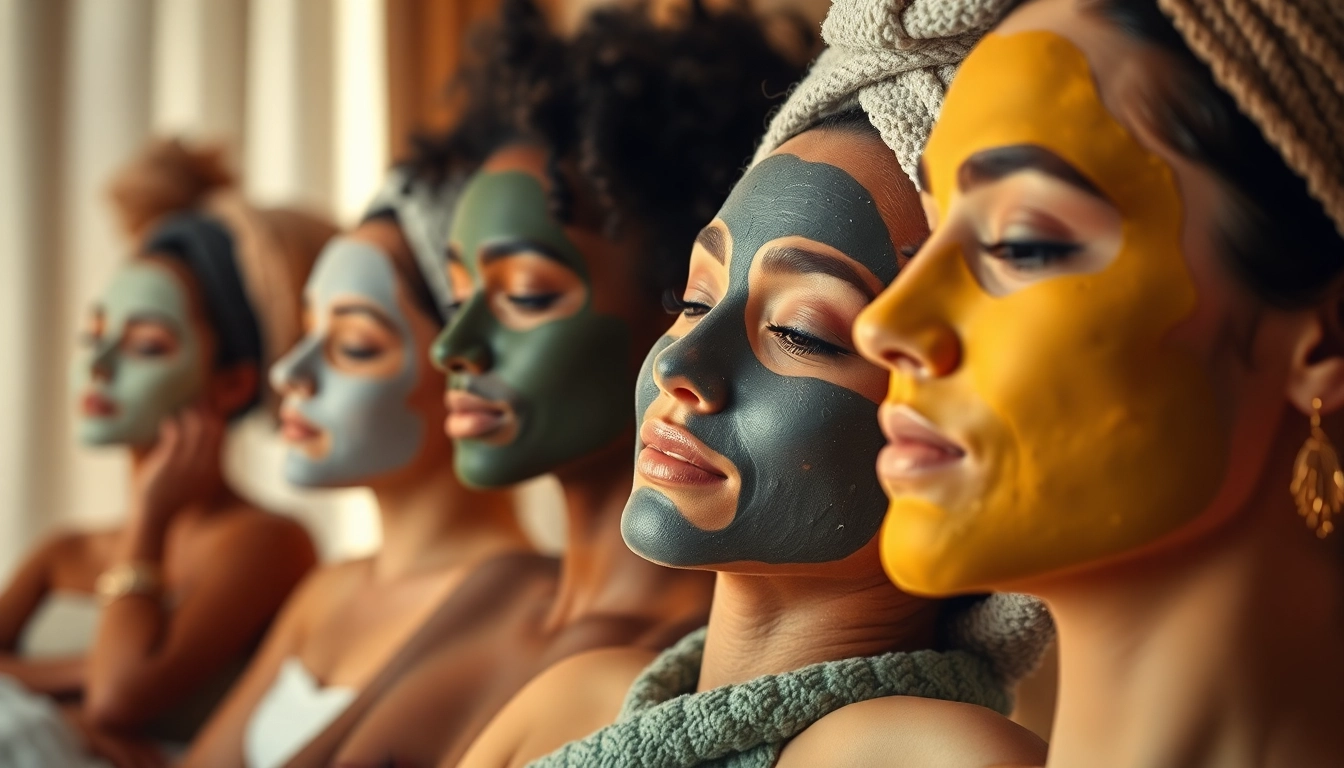
Understanding Facial Masks
What is a Facial Mask?
A facial mask is a skincare product applied directly to the face for a specified period, designed to address various skin concerns. These products come in various formulations and textures, from creamy masks to sheet masks, and are often enriched with beneficial ingredients. Facial masks serve to hydrate, exfoliate, brighten, tighten, and nourish the skin, providing both aesthetic and health benefits. They are a quintessential part of many skincare regimens, offering an easy method to achieve glowing, healthy skin. By incorporating a facial mask into your routine, you can significantly enhance your skin’s overall appearance and health.
Different Types of Facial Masks
Facial masks can be categorized based on their texture, formulation, and purpose:
- Cream Masks: Typically thicker and richer, these are designed to hydrate and nourish dry or mature skin.
- Clay Masks: Best for oily and acne-prone skin, they absorb excess oil and draw out impurities.
- Peel-off Masks: These masks adhere to the skin and provide exfoliation when peeled away, helping to remove dead skin cells.
- Sheet Masks: Made of paper or fabric, these are soaked in serums and provide hydration and other benefits based on their formulation.
- Bubble Masks: These contain ingredients that create a bubbly foaming effect, helping to cleanse the skin deeply.
- Overnight Masks: Applied before bed, these are designed to work while you sleep, providing intense hydration and nourishment.
How Facial Masks Benefit Your Skin
Facial masks offer a multitude of benefits for the skin, making them a popular choice in skincare routines. Here are some notable advantages:
- Deep Cleansing: Many masks help to remove dirt, oil, and impurities, contributing to clearer skin.
- Hydration: Masks with hydrating ingredients boost moisture levels in the skin, promoting softness and elasticity.
- Exfoliation: Certain masks provide gentle exfoliation, removing dead skin cells and helping to prevent clogged pores.
- Brightening: Ingredients like vitamin C in some masks can brighten dull skin and reduce the appearance of dark spots.
- Anti-Aging: Many masks contain antioxidants and peptides that help reduce the signs of aging.
Choosing the Right Facial Mask
Skin Types and Mask Compatibility
Understanding your skin type is crucial in selecting a facial mask that will yield the best results. Here’s a breakdown of what to look for:
- Dry Skin: Look for masks rich in hyaluronic acid, glycerin, or natural oils to provide essential moisture.
- Oily Skin: Opt for clay or charcoal masks that absorb excess oil and help minimize shine.
- Combination Skin: Choose masks that balance both hydration and oil control, like gel-based masks.
- Sensitive Skin: Seek out fragrance-free options with calming ingredients such as aloe vera or chamomile.
- Aging Skin: Masks with retinoids, peptides, or antioxidants aid in reducing fine lines and improving skin texture.
Key Ingredients to Look For
When selecting a facial mask, pay attention to the ingredients. Some key ones include:
- Hyaluronic Acid: A powerful humectant that draws moisture into the skin, making it ideal for hydration.
- Niacinamide: Strengthens the skin’s barrier and improves texture and tone.
- Salicylic Acid: Effective for acne-prone skin, helping to unclog pores and reduce breakouts.
- Charcoal: Excellent for detoxifying skin and absorbing impurities.
- Peptides: Amino acids that help in skin repair and promote firmness and elasticity.
Reading Labels Like a Pro
Understanding product labels is essential for making informed choices. Pay attention to the following:
- Ingredient Order: Ingredients are listed in descending order by concentration; the first five ingredients carry the most weight.
- Active Ingredients: Look for the presence of active ingredients that correspond with your skin concerns.
- Allergens: Check for any common allergens if you have sensitive skin.
- Expiration Dates: Always check when the product expires to ensure its efficacy.
Applying Facial Masks Correctly
Step-by-Step Application Guide
To maximize the efficacy of your facial mask, proper application is essential. Follow these steps:
- Cleanse: Start with a clean face. Use your regular cleanser to remove makeup, dirt, and oil.
- Exfoliate: If using an exfoliating mask, consider doing this before applying the mask for better result absorption.
- Apply Evenly: Using clean fingers or a brush, apply the mask evenly across your face, avoiding the eye area.
- Relax: Leave the mask on for the recommended time, usually between 10 to 20 minutes.
- Rinse Off: Gently rinse your face with lukewarm water, ensuring all product is removed.
- Moisturize: Finish with your regular moisturizer to lock in hydration.
Common Mistakes to Avoid
Even with a perfect product, application can affect results. Here are common mistakes to steer clear of:
- Not Cleansing First: Skipping cleansing can prevent the mask from penetrating effectively.
- Leaving it On Too Long: Following the time guidelines is crucial; too long can irritate the skin.
- Using Too Much Product: More isn’t better; using a thin layer is generally more effective.
- Ignoring Skin Pact: Check for reactions or irritation during the initial use; discontinue if adverse effects occur.
Maximizing Benefits with Proper Use
To enhance the benefits of your facial masks, consider the following:
- Frequency: Use masks 1-3 times a week, depending on your skin type and mask intensity.
- Temperature: Warm your face or apply a warm cloth to open pores before application for deeper penetration.
- Layering: For complex skincare routines, consider layering masks (for example, a purifying clay mask followed by a hydrating gel mask).
Facial Masks in Your Skincare Routine
When to Use Facial Masks?
Incorporating facial masks into your routine is about timing. Here are ideal moments to apply them:
- Weekly Maintenance: For regular upkeep, using a mask weekly can maintain skin health.
- Before Events: To prep for special occasions, apply a mask 1-2 days prior to get your skin glowing.
- Seasonal Changes: Adjust your mask choice based on seasonal skin changes, for instance switching to hydrating masks in winter.
Combining Masks with Other Treatments
Facial masks can work synergistically with other skincare products and treatments. Consider these combinations:
- Serums: Layering a hydrating serum under your mask can amplify hydration.
- Moisturizers: Follow up with a moisturizer to seal in the benefits of the mask.
- Spot Treatments: For problem areas, apply targeted treatments along with your mask for optimal effect.
Creating a Personalized Routine
Your skincare routine should reflect your skin’s unique needs. Here’s how to create a personalized regimen:
- Assess Your Skin: Identify your skin type, concerns, and goals.
- Select Products: Choose facial masks that align with your skin’s needs and schedule.
- Establish a Routine: Determine how often to use masks and plan your routine accordingly.
- Monitor Results: Keep track of how your skin responds and adjust your product usage as needed.
Staying Informed: Trends and Innovations
Emerging Trends in Facial Masks
The skincare industry is ever-evolving, and facial masks are no exception. Here are some current trends:
- Biodegradable Masks: Environmentally friendly masks are on the rise, reducing waste without sacrificing effectiveness.
- Customization: Brands offering bespoke masks tailored to individual skin types and concerns are becoming increasingly popular.
- Microbiome-Friendly Products: Facial masks enriched with probiotics that support the skin’s natural microbiome.
Product Recommendations and Reviews
When choosing facial masks, research can guide you to the best products. Some recommended masks include:
- SK-II Facial Treatment Mask: Known for its hydrating and brightening effects due to its rich Pitera content.
- Aztec Secret Indian Healing Clay: A favorite for deep pore cleansing, especially among those with oily skin.
- Tatcha Luminous Dewy Skin Mask: Great for hydration, leaving the skin with a dewy glow.
Research and Development in Skincare
Continuous research into skincare ingredients and technologies is at the forefront of product development. Key areas of focus include:
- Nanotechnology: Developing smaller molecules for better absorption of active ingredients.
- Natural Ingredients: Increased demand for formulations based on botanical extracts and minimal processing.
- Clinical Testing: Ensuring product efficacy and safety through thorough scientific research.





